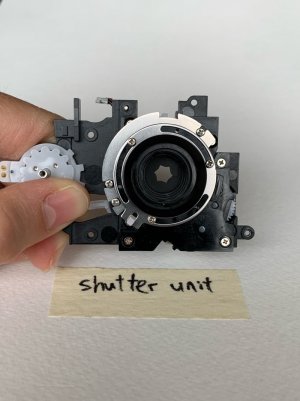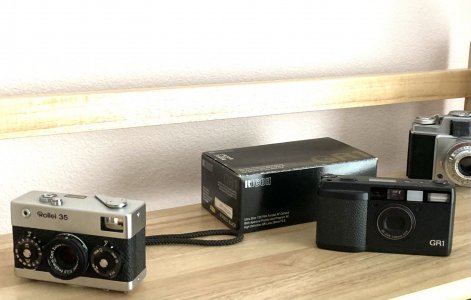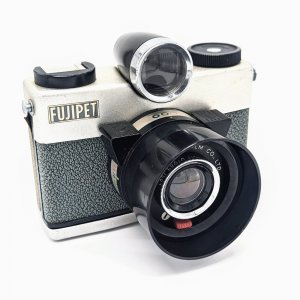Pál_K
Cameras. I has it.
To be accurate, the image area doesn't seem larger - it is larger. Not a lot, but at least it's not smaller. My whole point was that in the 1960's 135-format could've been improved in the same manner Regular 8mm ("Double 8mm") on spools was improved by Super-8, which not only had a larger image area (touted by everyone), but also had the convenient cassettes. The same strategy could've been applied to 135. Not in 1995, but maybe 1965.Yes, the *area* increase seems larger, but that's because it's always a square-function of the linear dimensions. You're only making the frame +4 x +6 mm larger, which isn't much to speak of in linear terms, and is typically as much as what's lost in a photofinisher's negative carrier and printing mask anyway.
I do realize Kodak and others had the goal of increasing sales and profits by introducing convenient film loading and smaller cameras, all aimed at the non-enthusiast photographer. I suppose they succeeded.
CMur12
Well-known
Kodak's old 828 rollfilm was bascially 35mm without the sprocket holes. As I recall, the image area was larger, but due to the paper backing, there were fewer exposures per roll. Cameras for 828 film also required no rewind mechanism.
The original Kodak Pony camera (around 1950) came in 828 before the 35mm version was introduced.
- Murray
The original Kodak Pony camera (around 1950) came in 828 before the 35mm version was introduced.
- Murray
Last edited:
das
Well-known
APS was a terrible idea.
das
Well-known
It seems to me that there are really just two types of people into film photography these days. Those who want a serious camera to learn the craft and those who want to point and shoot for fun. Where does a presumably expensive new AF point and shoot fit into the spectrum? But I welcome all new film cameras to add to the supply that may still be working 50 years from now.
It is a point and shoot in size not in usage. From an old update: "This is the shutter, borrowed from existing Mint camera designs and has proven to work well. Although the basic design hasn't changed, we upgraded the speed of this shutter electronically to make it faster. It took us quite a while just to get this part right - battling with shutter speed testers, high speed cameras, a lot of components, and some clever programming... man am I glad it works now and I really hope it'll pay off."It seems to me that there are really just two types of people into film photography these days. Those who want a serious camera to learn the craft and those who want to point and shoot for fun. Where does a presumably expensive new AF point and shoot fit into the spectrum? But I welcome all new film cameras to add to the supply that may still be working 50 years from now.
It clearly shows a shutter speed dial attached to the shutter unit... at least to me. The other Mint cameras have a shutter speed dial. If it has a shutter speed dial and aperture ring, there is nothing stopping it from being a serious camera to use. I mean, people have always used point and shoot style cameras for serious photography. Diado Moriyama (Ricoh GR) and Chris Anderson (Contax T3) spring to mind immediately. Also, what you say about film users is exactly the same thing you can say about cameras and photography in general.

Godfrey
somewhat colored
Who will buy one? Anyone who wants a *new*, quality, compact 35 with the features that it provides, who else? Same kind of people who once bought Rollei 35, Minox 35, Petri 35, Olympus Stylus, et al.
Why bother with these sorts of questions? Who the manufacturer is looking for as market audience is their issue. Why not respond to whether the camera is interesting to *you* instead, and what your concerns about it might be?
Why bother with these sorts of questions? Who the manufacturer is looking for as market audience is their issue. Why not respond to whether the camera is interesting to *you* instead, and what your concerns about it might be?
ptpdprinter
Mentor
Would the same people who bought a Rollei 35, Minox 35, Petri 35, Olympus Stylus, et al. 50-70 years ago buy a MiNT 35 in 2024, or would they just use their phone?Who will buy one? Anyone who wants a *new*, quality, compact 35 with the features that it provides, who else? Same kind of people who once bought Rollei 35, Minox 35, Petri 35, Olympus Stylus, et al.
Why bother with these sorts of questions? Who the manufacturer is looking for as market audience is their issue. Why not respond to whether the camera is interesting to *you* instead, and what your concerns about it might be?
Why limit the discussion of the MiNT 35 to its unknown features and ignore its target market? Presumably MiNT did some market research before engaging in this venture. I am interested in what people do and why.
Well, those people are likely not alive anymore. If you are into photography, you most likely have a phone and several other cameras. I would think that many people had those cameras you mentioned plus other cameras.Would the same people who bought a Rollei 35, Minox 35, Petri 35, Olympus Stylus, et al. 50-70 years ago buy a MiNT 35 in 2024, or would they just use their phone?
It's ok with me... wanting to understand people. What I do not understand is thinking there isn't an audience for this. I would imagine Mint knows it is a niche and a niche they are comfortable with. Let's be honest, if they were looking to become filthy rich, they are in the wrong industry.Why limit the discussion of the MiNT 35 to its unknown features and ignore its target market? Presumably MiNT did some market research before engaging in this venture. I am interested in what people do and why.
das
Well-known
Some relatively well-off people bought expensive compacts in the late 60s and 70s like the Rollei 35 because there was a specific demand for a high quality, easy to use compact camera where the alternatives were bigger, heavier, more complicated (SLRs), or cheaper models with less functionality and mediocre optics. We don't live in that era anymore and no one currently is facing those precise choices -- as jsrockit mentioned, we have our phones for unlimited throwaway / everyday shots. If the target market for the MINT are people who want a "new" Contax T2/T3 equivalent, that is also very specific group of people. Also, this may be an unpopular opinion, but despite its price, I don't think the Contax T3 is a "serious" camera. It is not even as serious as the Konica Hexar AF, which is only arguably semi-serious, but at least it has some real-time autofocusing feedback with its collapsing framelines, has far more functionality, and employs a multicoated version of a legendary optic with automatic focus shift control. Even when they came out, I always viewed the T3 and the Nikon Ti as rich people's ski vacation cameras (perfect in the ski jacket pocket!), although some real photographers have used cameras like those to some great effect.
It is true, but I think the results were very good. I used the Contax T2 and Leica Minilux and they were very good cameras. The results were anyway. Of course, now they seem primitive. Oh, and I was far from rich... and never skied ever, but cameras were important and I have always known the importance of a take anywhere camera. These days I use the Ricoh GRIIIx and it is every bit as serious of a camera as any other 24mp APSC camera with a 40mm equivalent lens.Also, this may be an unpopular opinion, but despite its price, I don't think the Contax T3 is a "serious" camera. It is not even as serious as the Konica Hexar AF, which is only arguably semi-serious, but at least it has some real-time autofocusing feedback with its collapsing framelines, has far more functionality, and employs a multicoated version of a legendary optic with automatic focus shift control. Even when they came out, I always viewed the T3 and the Nikon Ti as rich people's ski vacation cameras (perfect in the ski jacket pocket!), although some real photographers have used cameras like those to some great effect.
I think Mint and Pentax can improve on these 90s cameras. Better AF and AF confirmation info, higher max shutter speed (that Konica AF had a max shutter speed of 1/250th!), newer battery types or at least ones that are readily available etc. We will see. Do I want it? Yes. Do I need it, no. Will I buy it... well, if the lens isn't plastic and they do not handicap the top shutter speed and provide a decent range of apertures while making it at a sensible price, yes.
Last edited:
JeffS7444
Well-known
It's great to see this prototype looking so real, in the sense of tricky bits existing as functioning stamped and injection-molded assemblies, rather than renderings. Lomography had great timing by becoming involved with Lomo LC-A production while the factory and it's workforce were still intact. But for other companies, including Pentax, it seems that much must be rebuilt/re-learned from scratch.
Retro-Grouch
Mentor
Mint's entire game, so far, has been to address niche markets. The number of Instax users who want a higher-end, adjustable camera capable of quality images is tiny compared to the vast population of instant-camera users. Mint addressed that niche brilliantly and very successfully, and even those who don't shoot instant film should be glad that those products exist for those who want them.Well, those people are likely not alive anymore. If you are into photography, you most likely have a phone and several other cameras. I would think that many people had those cameras you mentioned plus other cameras.
It's ok with me... wanting to understand people. What I do not understand is thinking there isn't an audience for this. I would imagine Mint knows it is a niche and a niche they are comfortable with. Let's be honest, if they were looking to become filthy rich, they are in the wrong industry.
ptpdprinter
Mentor
I don't know how many new SX70 compatible cameras (RF70/SF70/TL70) MiNT actually sold compared to refurbished SX70s. I would guess they sold more refurbished SX70s, but I have no inside sales and financial information. The owners of MiNT have said they are betting the company on the new 35mm point and shoot. Have they saturated the SX70 market with their prior offerings? Will they be able to continue offering their SX70 offerings if the new 35mm camera is not as unsuccessful as hoped?Mint addressed that niche brilliantly and very successfully, and even those who don't shoot instant film should be glad that those products exist for those who want them.
Godfrey
somewhat colored
I bought my Rollei 35S 42 years ago because i was traveling a lot and wanted a compact camera that would produce quality on par with my existing Nikon/Leica 35mm equipment. Still does today. I produced and sold professionally many, many photos with the Rollei 35S and Minox 35GT-E.
If i were shooting 35mm film today, and wanted a high quality compact camera, of course the Mint 35 would be of interest. I could use my iPhone, but then i wouldn't be shooting with film, right?
My iPhone produces excellent quality photos but cannot compete on par with either the Leica M10 or Light L16. So it is not the modern equivalent of the Rollei 35S in the digital domain.
i remain perplexed that so many people worry about what other people might buy rather than discuss what they might or might not like about a particular camera design. I personally don't care much what other people might want to buy because I'm not intending to be in the business of manufacturing cameras for other people to buy. I'm interested in what manufacturers are designing so as to know what might be useful or advantageous to my photography.
G
If i were shooting 35mm film today, and wanted a high quality compact camera, of course the Mint 35 would be of interest. I could use my iPhone, but then i wouldn't be shooting with film, right?
My iPhone produces excellent quality photos but cannot compete on par with either the Leica M10 or Light L16. So it is not the modern equivalent of the Rollei 35S in the digital domain.
i remain perplexed that so many people worry about what other people might buy rather than discuss what they might or might not like about a particular camera design. I personally don't care much what other people might want to buy because I'm not intending to be in the business of manufacturing cameras for other people to buy. I'm interested in what manufacturers are designing so as to know what might be useful or advantageous to my photography.
G
Last edited:
agentlossing
Well-known
I'm more and more interested. I have a spot for a small film camera in my general setup (the idea is to have a large/system camera and a compact in both digital and film) currently being filled by the Lomo LC-A but that is definitely a niche camera. And the concept of a manual wind (is this manual? Looks like it so far maybe?) but autofocus 35mm compact sounds fun.
Retro-Grouch
Mentor
Who has the greater financial resources, Mint or Pentax? And who seems closer to releasing their camera? Seems like Mint! There's often an advantage to little companies that are more flexible. It sounds like gearing up for a new film camera at Pentax is akin to turning an ocean liner around.
Pál_K
Cameras. I has it.
Am I the only one who thinks that Ricoh/Pentax would have a real winner if they'd just re-introduce the film GR cameras?... It sounds like gearing up for a new film camera at Pentax is akin to turning an ocean liner around.
The GR-1 and other models having the fixed-focus and "snap" mode in addition to having AF is a street photographer's dream.
Great lens, aperture-priority, program mode, EV adjustments, great viewfinder and displays, magnesium body, shirt-pocket camera - amazing for 1996. It deserved more and longer support. It might be a winner today.
Or, like the Saturn V rocket, it can't be built today?

agentlossing
Well-known
Agreed, I just think the cost for Ricoh to reintroduce the GR exactly like it was in the 1990s would be cripplingly high. I'd love if they did the GR21 (or a digital GR version with a 21mm equiv lens).Am I the only one who thinks that Ricoh/Pentax would have a real winner if they'd just re-introduce the film GR cameras?
The GR-1 and other models having the fixed-focus and "snap" mode in addition to having AF is a street photographer's dream.
Great lens, aperture-priority, program mode, EV adjustments, great viewfinder and displays, magnesium body, shirt-pocket camera - amazing for 1996. It deserved more and longer support. It might be a winner today.
Or, like the Saturn V rocket, it can't be built today?
View attachment 4824839
Godfrey
somewhat colored
I'm more and more interested. I have a spot for a small film camera in my general setup (the idea is to have a large/system camera and a compact in both digital and film) currently being filled by the Lomo LC-A but that is definitely a niche camera. And the concept of a manual wind (is this manual? Looks like it so far maybe?) but autofocus 35mm compact sounds fun.
I've been intrigued and interested in the Lomo LC-A 120 for some time. I'm just not sure I'd use it enough, but I might go for that, as companion to my Voigtländer Perkeo II
Who has the greater financial resources, Mint or Pentax? And who seems closer to releasing their camera? Seems like Mint! There's often an advantage to little companies that are more flexible. It sounds like gearing up for a new film camera at Pentax is akin to turning an ocean liner around.
Well, if Ricoh/Pentax doesn't have greater resources, then something is quite amiss with their business!
But I'm pretty sure MiNT will release first, because the products that MiNT does are Gary's personal mission, rather than a "real business" production issue like Ricoh/Pentax would have to do or lose most of their already tainted credibility.
The Ricoh GR was a fine camera, but I never liked shooting with it as much as the Rollei 35S or Minox 35GT-E because a 28mm lens is right on the edge of "too wide for general purpose use" for me. However, a GR with a 21mm wide angle would be interesting/appealing as a specialty camera for my use, just like the Lomo LC-A 120.
G
das
Well-known
Share:
-
This site uses cookies to help personalise content, tailor your experience and to keep you logged in if you register.
By continuing to use this site, you are consenting to our use of cookies.


